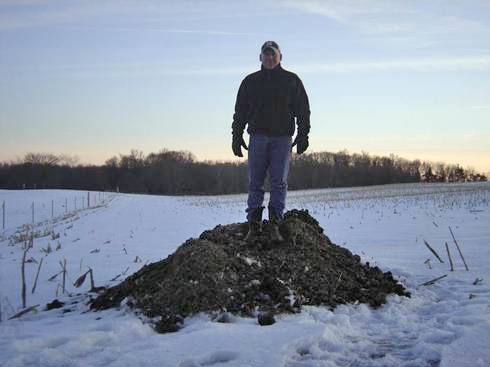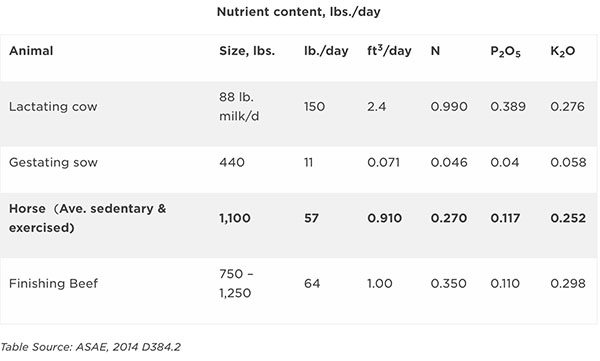Developing a Horse Manure Management Plan- Part 1- Volume and Collection
By: Tom Guthrie and Erica Rogers, Michigan State University Extension
This is article 1 of 8, Developing a horse manure management plan – Volume produced and collection
Overwhelmed by horse manure? If you answered yes to this question, which seems to be a popular answer in most cases, it may be time to reevaluate your current management practices. Developing a horse manure management plan may seem like a daunting task but it doesn’t necessarily need to be. Another common interpretation is that horse manure management has to be an all or nothing approach. This is not necessarily the truth, as many plans are developed and implemented using an integrated approach. Departmentalizing the components of a manure management systems plan allows you to evaluate what’s feasible, what options may be available, as well as developing a sustainable plan for the future.
Before anything else, it is a good idea to think about, write down, or even draw a map of what encompasses your respective horse farm. Three key points to consider here include:
- Describe your horse farm – goals, objectives, partnerships, business opportunities, recreation
- Land base resources – Identify how many acres you own or lease and how many of these acres are “usable.” For the purpose of this article series, we will refer to usable acres as acres that are appropriate for specifically managing and/or taking care of your horse. Acres to exclude from this calculation would be any area where manure should not be spread or acres that are not feasibly appropriate to spread manure. These areas may include: wetland and/or wooded areas, acres that encompass where your home, barn, riding arena, etc. are located.
- Number of horses that currently reside on your farm
By doing this initial exercise, you get an unbiased perspective as a starting point rather than a reactive attempt at a solution.
Volume Produced
The next step is to calculate how much manure is being produced by your horses. In general terms, a 1,000 lb. horse will produce approximately 50 lbs. of manure in a day. Below is an example calculation.
Manure volume produced by 1 horse per month:
1,000 lb. horse = 50 lbs. manure/day
50 lbs. manure X 30 days = 1,500 lbs. of manure/month/horse
If your horse is stalled: for every 1 lb. of manure add 0.3 lbs. wood shavings
1,500 lbs. manure/month + 450 lbs. shavings = 1,950 lbs. feed stocks (manure + shavings)/horse/month
If you wish to get more specific with your calculations, the table below illustrates daily manure production and characteristics, as excreted.
This table also indicates the nutrient contents Nitrogen (N), Phosphorus (P2O5) and Potassium (K2O) . These values will be referred to later on in the article series when considering manure utilization.
Now, you may be thinking that is all well and good but question, what if my horse only weighs 800 lbs.? One logical way to determine this would be to pro-rate volume produced to the specific weight of your horse.
So, for example: An 1,100 lb. horse = 57 lbs. of manure produced/day
- 1,100 lb. horse / 100 lbs. of body weight = 11
- 57 lbs. of manure produced /11 = 18 lbs. per 100 lbs. of body weight
Therefore, an 800 lb. horse (8 x 5.18 lbs. per 100 lbs. of body weight) = 41.44 lbs. of manure produced per day.
Having an accurate idea of how much horse manure you are dealing with on a monthly basis will be extremely helpful in the planning process as well as helping you understand if your land base resources are adequate.
Manure Collection
When considering collection of manure on your horse farm, try to identify all the possible scenarios of where you may potentially collect horse manure. Some examples are below:
Pastures
Manure is naturally distributed on pastures by horses, no effort is made to collect manure from pastures. This does NOT mean you get a free pass; manure still has to be managed in some way. Manure is broken up and nutrients distributed when pasture is clipped, therefore the nutrients are naturally recycled by the grass. If necessary, a chain harrow is used on hot dry days to break up manure and distribute within the pasture.
Dry lot- Manure from dry lot is collected – daily, bi-weekly, weekly
Run-in shed- Manure is collected and distributed on pasture before clipping, state however many times per year
Stalled Horses- Manure and bedding is collected from stalls 2 x per day
Exercise/Turnout lot- Manure is collected 2 x per week
Riding arena- Manure is collected as needed
With this information in hand, now you can start to formulate the volume of manure you may be collecting from each location depending on how your horses are managed.
Take the following scenario for example:
You have four horses. Two of the four horses are managed on pasture from April – November. All other times they can be stalled or housed in the dry lot. The other two horses are show horses. They are gone from the farm 45 days of the year to shows. When at the farm – housing for these two horses include stalls and exercise/turnout lot (average time per day = 12 hours stalled – 12 hours outside).
The formula needed for collection calculation would be: Number of animals X total days or time spent in that respective housing unit X amount of manure produced within that time frame.
The idea is to break out the time for how you specifically manage your horses (what type of housing and time frame spent in that respective unit) allowing for a fairly accurate estimation and accountability for manure produced and collected.
Look for the next article- Developing a horse manure management plan series – Part 2: Manure Storage- that will focus on the considerations manure storage revolving around handling, storing, managing and ensuring environmental stewardship within the decision making process.












